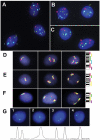Aneuploidy and confined chromosomal mosaicism in the developing human brain
- PMID: 17593959
- PMCID: PMC1891435
- DOI: 10.1371/journal.pone.0000558
Aneuploidy and confined chromosomal mosaicism in the developing human brain
Abstract
Background: Understanding the mechanisms underlying generation of neuronal variability and complexity remains the central challenge for neuroscience. Structural variation in the neuronal genome is likely to be one important mechanism for neuronal diversity and brain diseases. Large-scale genomic variations due to loss or gain of whole chromosomes (aneuploidy) have been described in cells of the normal and diseased human brain, which are generated from neural stem cells during intrauterine period of life. However, the incidence of aneuploidy in the developing human brain and its impact on the brain development and function are obscure.
Methodology/principal findings: To address genomic variation during development we surveyed aneuploidy/polyploidy in the human fetal tissues by advanced molecular-cytogenetic techniques at the single-cell level. Here we show that the human developing brain has mosaic nature, being composed of euploid and aneuploid neural cells. Studying over 600,000 neural cells, we have determined the average aneuploidy frequency as 1.25-1.45% per chromosome, with the overall percentage of aneuploidy tending to approach 30-35%. Furthermore, we found that mosaic aneuploidy can be exclusively confined to the brain.
Conclusions/significance: Our data indicates aneuploidization to be an additional pathological mechanism for neuronal genome diversification. These findings highlight the involvement of aneuploidy in the human brain development and suggest an unexpected link between developmental chromosomal instability, intercellural/intertissular genome diversity and human brain diseases.
Conflict of interest statement
Figures


References
-
- Feuk L, Carson AR, Scherer SW. Structural variation in the human genome. Nature Rev Genet. 2006;7:85–97. - PubMed
-
- Sharp AJ, Cheng Z, Eichler EE. Structural variation of the human genome. Annu Rev Genomics Hum Genet. 2006;7:407–442. - PubMed
-
- Muotri AR, Gage FH. Generation of neuronal variability and complexity. Nature. 2006;441:903–910. - PubMed
-
- Iourov IY, Vorsanova SG, Yurov YB. Chromosomal variations in mammalian neuronal cells: known facts and attractive hypotheses. Int Rev Cytol. 2006;249:143–191. - PubMed
-
- Hassold T, Hunt P. To err (meiotically) is human: the genesis of human aneuploidy. Nat Rev Genet. 2001;2:280–291. - PubMed
Publication types
MeSH terms
LinkOut - more resources
Full Text Sources
Other Literature Sources

